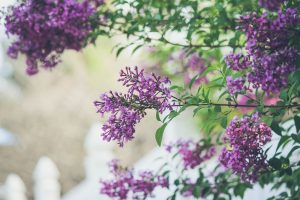August 11, 2020
Contact: Bill Halfman, UW Extension Agriculture Agent
Phone: 608-269-8722
What is Going on with the Lilacs??
In most years, lilacs tend to be relatively disease free. When sited properly (in full sun) and pruned/thinned regularly, they reliably produce a bounty of beautiful blooms each spring in a myriad of colors. And oh that scent! Is there really anything that smells better than the scent of lilacs in full bloom?
Due to some later spring frosts there were some problems with the flowers this year. More recently I have received a lot of phone calls and e-mails asking “Why are my lilacs leaves turning brown?”
Septoria Leaf Spot is the answer to the question of What is Going on with the Lilacs? Brian Hudelson, UW Plant Disease Diagnostic Clinic provides the following information on this disease.
 Septoria Leaf Spot has been the number one disease this season on lilac (and is towards the top of my disease list for all plants). Symptoms are lilacs with leaves that have partially or fully browned starting at the bottom of the shrub and working up the plant. The culprit in this browning appears to be a species of Septoria, a fungus related to (but distinct from) the organism that causes Septoria leaf spot of tomato.
Septoria Leaf Spot has been the number one disease this season on lilac (and is towards the top of my disease list for all plants). Symptoms are lilacs with leaves that have partially or fully browned starting at the bottom of the shrub and working up the plant. The culprit in this browning appears to be a species of Septoria, a fungus related to (but distinct from) the organism that causes Septoria leaf spot of tomato.
While the browning caused by this disease is quite dramatic, the disease is not lethal. If you look carefully at the branches with symptomatic leaves, you should be able to find healthy leaf buds at the base of the petioles of this year’s leaves. These buds are ready to sprout next spring to produce a new crop of leaves.
Good fall clean-up is the place to start in managing Septoria leaf spot. Good fall clean-up is collecting up the leaf debris from your lilacs, and burn (where allowed), bury or compost the leaf debris. Routine pruning/thinning to open the canopy and promote rapid drying of leaves when they get wet will also help keep this disease at bay. A guide to pruning and thinning can be found at this link: https://go.wisc.edu/x6h3tk
If we continue to see wetter summers, this disease may become a chronic, severe problem, and use of fungicides to manage the disease may become necessary. However, I suspect we will cycle into a series of drier summers over the next couple of years, and if we do, I would expect the severity of this disease to decrease, and no fungicide treatments will be needed.



